Minoan Civilization
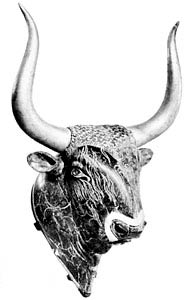
After viewing again the videos I filmed during my visits to the various archeological sites of Crete, I have created this small, let ’s call it, guide of the Minoan Civilization. In case this is the first time you ’ve heard of Minoan Civilization, just keep on reading. I am neither an archeologist nor a tourist guide, but I believe I have managed to concentrate all basic information on the ancient civilization of my beloved Crete!
The Minoan Civilization was a civilization that arose on Crete during the Bronze Age. It is believed to have been the first civilization in the European Continent. From 2700 BC to 1450 BC the Minoan Civilization flourished , not only on the island of Crete, as it affected the nearby islands, too. It is believed that the beginning of the end of the Minoan Civilization is the eruption around 1600 BC of the volcano of Santorini island... but we ’ll talk about this later on.
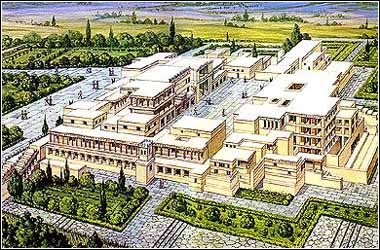
The Discovery of Minoan Civilization...
It has been Sir Arthur Evans, a famous British archeologist, that brought to light, back in the end of 19th century the ruins of the Minoan Civilization. Today one can find Evan ’s sculpture at the archeological site of Knossos, but most importantly one can find and admire his work; the excavations of Knossos and the famous Palace of King Minos.
The Palace of King Minos at Knossos is the one that the ancient Greeks considered a Labyrinth. It has been the largest of all palaces of the time and also the most impressive. It had two levels and numerous chambers which walls were decorated with frescos.
I ’ve already told you about the legend of Minotaur , Theseus and Ariadne ’s ball of twine.
These made Knossos famous at ancient times...today it is the 20000sqm archeological site that makes Knossos that famous. Being one of the most visited Greek monuments, I ’ve been also there myself couple of times. So I am going to tell you few things about it...lets say the necessary stops a visitor of the archeological site should make:

STOP 1: THRONE ROOM
Yeah...if you visit a palace, you cannot miss the throne room! At Knossos, the palace is open-air (ceilings are distructed), but the throne room is well preserved. Though it ’s dark, you can admire beautiful fresco decorating the throne room ’s walls. The basic color is red and it depicts griffins looking at the direction of the throne. Oh! By the way you can also see the throne of the famous King Minos, perfectly preserved ( I really wished I could sit on it, feel like an original Cretan King...wishful thinking !). Interestingly from all the Minoan palaces only that of Knossos seemed to have a throne room.
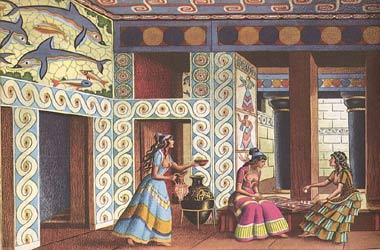
STOP 2: QUEEN ’S APARTMENTS
Every King always has his queen, and every queen has her personal apartments. These are also a must for visitors of Knossos. Admire the beautiful dolphin fresco ( but bare in mind that its just a copy...the real one is at a museum for its best preservation). Travel back to Minoan Crete and imagine the beautiful queen with her colorful robe which did not cover her breast, her long curly hear, her bronze big earrings...(King Minos must have been a lucky man!)
Lets get a bit more serious...
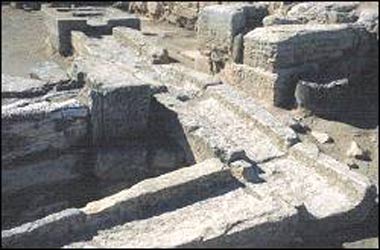
STOP 3: LIQUID MANAGEMENT SYSTEM
All over the archeological site of Knossos a visitor may notice the advanced liquid management system used by the Minoans. They did not only have a supply management system, but also one for drainage of runoff and one for drainage of waste water. Louis XIV would certainly be jealous of this liquid management system! In contrast to Versailles that did not have a single toilet, all over the palace there have numerous bathrooms with that of the queen setting the example. The queen had next to her apartment a bathroom with a clay tub!
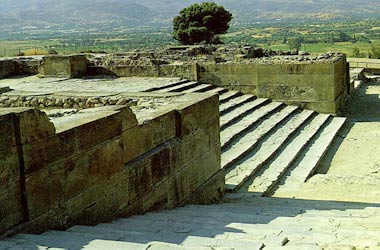
Phaistos Palace
You might have heard of Phaistos Disc but did you know that at Phaistos there is also a Palace? Phaistos lies in the southern Crete at the Prefecture of Heraklio. The Palace of Phaistos was discovered in the 1950. To be honest the archeological site is neither as big as the one of Knossos nor as impressive. But when walking around Phaistos at the ruins of the palace, under the hot Greek sun and thinking of how old the palace is and how it would look like back then... you feel deeply amazed.
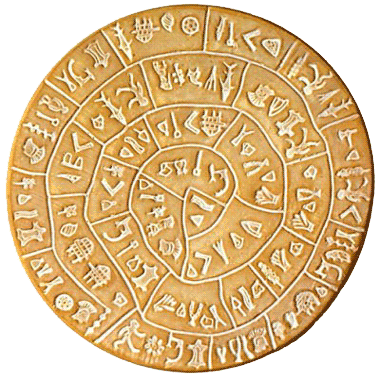
Phaistos Disc
The first time I ’ve been to Phaistos archeological site, I expected to find there also the famous Phaistos Disc. To my disappointment the disc was 50km away, at the Archeological Museum of Heraklio. I anyway wanted to visit this museum (which I also highly recommend), and the Phaistos Disc was an extra motive for me. As a kid, at school I have heard again and again the history of the Minoan Crete, the tales about King Minos, the Minotaur and its Labyrinth and the mysterious Phaistos Disc. I was that impressed by the fact that none has managed to decipher it, that I started to believe that this disc had magical powers or that it derived from another unknown dimension.
When I visited the Archeological Museum of Heraklio, I have forgotten all this childish thoughts of mine on the disc – it took me just a moment to remember all of them! Standing in front of an object that was inspiration for imaginary stories of my childhood, made me feel strangely happy! The truth is the no one has managed to decipher Phaistos Disc – but it is no more considered a mysterious item from the past... Phaistos Disc is made out of clay and its inscripted on both its sides. It was constructed by pressing pre-formed hieroglyphic "seals" into the soft clay, and was discovered in 1908. It is believed to be a catalog or diary.
Malia Palace
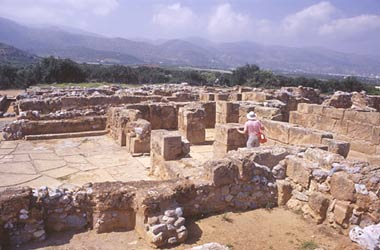
Malia is not only a pole of tourist attraction, not just the place full with hotel units, wild nightlife and beautiful beaches. Malia is also an area of great archeological interest. It is in the Prefecture of Herakli oand very cloze to Lasithi Prefecture, too. Though it has the same size with the palace of Phaistos, less people visit it. It is true only part of the Malia excavation is open to public. Anyway, for those who wish to get some information on Malia archeological site I could help you: In case you have visited the other Minoan Palace of Crete, you will understand that the Palace of Malia differs. It is not its structure that separates it from the other 3 palaces, but its location. It is built rather cloze to the sea, which according to archeologists is a sign of lack of fear of hostile attacks. Many scientists believe that for many years there has been a kind of pax Minoica (or Minoan peace). The little evidence for ancient fortifications supports the assumption that there was little internal or external armed conflict.
If you have read up to hear then, you ’d make me really happy. To compensate you I ’ll quit my narrations on archeological sites, and inform you of some interesting facts of the Minoan Civilization of Crete:
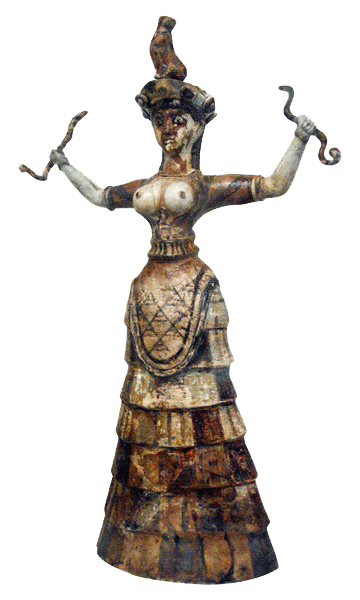
Did you know that...
1. Almost all deities the Minoans worshiped were women
One of the most famous goddesses has been the Goddess of fertility, which was a mother. Logically, the priestesses of the Minoans were also women. One of the most famous statuettes is the so called Snake Priestess (which you can find the Archeological Museum of Heraklio)
2. Women ’s position in the Minoan society was prominent
Not only were the major deities worshiped female, but Minoan women in general enjoyed the same respect and rights with men. The evidence we have is few, but strong. Characteristic is one of the most famous frescoes of Minoan Crete: It depicts both men and women taking part is athletic events and celebrations.
3. It is believed that the eruption of Santoni ’s volcano was the beginning of the end of the Minoan Civilization
In 1600 the volcano of island of Santorini, which is 100km on the north of Crete island, erupted. The destruction provoked was immense; more than half of the island of Santorini collapsed and this is thought that has provoked enormous waves ( tsunamis)/ These reached the island of Crete. Though some researchers claim that the giant waves destroyed the palaces and towns of the northern Crete, I believe we should consider a (non-Hollywood-like) realistic theory. What if the waves provoked by the volcanic eruption destroyed the Minoan ports and all their navy and vessels? Is the destruction of the navy of a sea power, like the Minoans, reason enough for the start of its downfall? Oh, yes it is...!
4. Three different alphabets have been found up to now at the Minoan Archeological sites.
It is the hieroglyphic alphabet of the Phaistos Disc (see above). in Linear A scripts have been found, as well as scripts in Linear B alphabet. The latter was deciphered was deciphered after the Second World War, but Linear A still remains an unknown language.
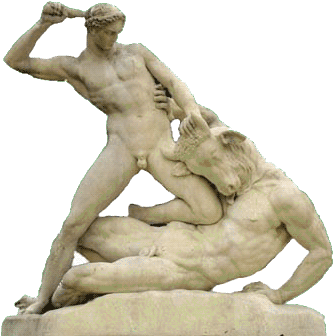
5. We can not say for sure yet, who King Minos was...
According Greek Mythology Minos was the son of king of gods Zeus and Europa. His daughter Ariadne has helped Theseus beat the mythic monster Minotaur, who lived in Knossos. After his death, Minos became a judge of the dead in Hades. Now according to researchers ( a more reliable source compared to mythology!) it is not sure if a king named Minos, actually existed. They consider that Minos was the word they used for king. Anyway, what I can tell you for sure that they ancient Minoans, did not refer to them self this way. The phrase “Minoan” Civilization is attributed to Sir Arthur Evans, who labeled the civilization after his legendary king.
I could keep on, but I don ’t mean tiring you more. Therefore I urge you all to discover yourselves the rest on the Minoan civilization, by visiting Crete!





